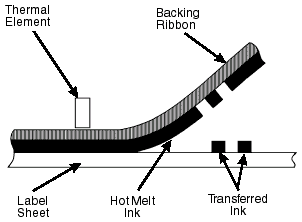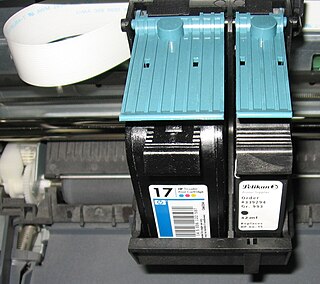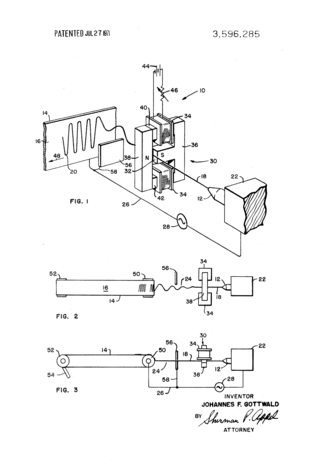
In the field of computing, a printer is considered a peripheral device that serves the purpose of creating a permanent representation of text or graphics, usually on paper. While the majority of outputs produced by printers are readable by humans, there are instances where barcode printers have found a utility beyond this traditional use. Different types of printers are available for use, including inkjet printers, thermal printers, laser printers, and 3D printers.

Screen printing is a printing technique where a mesh is used to transfer ink onto a substrate, except in areas made impermeable to the ink by a blocking stencil. A blade or squeegee is moved across the screen to fill the open mesh apertures with ink, and a reverse stroke then causes the screen to touch the substrate momentarily along a line of contact. This causes the ink to wet the substrate and be pulled out of the mesh apertures as the screen springs back after the blade has passed. One colour is printed at a time, so several screens can be used to produce a multi-coloured image or design.

Inkjet printing is a type of computer printing that recreates a digital image by propelling droplets of ink onto paper and plastic substrates. Inkjet printers were the most commonly used type of printer in 2008, and range from small inexpensive consumer models to expensive professional machines. By 2019, laser printers outsold inkjet printers by nearly a 2:1 ratio, 9.6% vs 5.1% of all computer peripherals. As of 2023, sublimation printers have outsold inkjet printers by nearly a 2:1 ratio, accounting for 9.6% of all computer peripherals, compared to 5.1% for inkjet printers.

Dye-sublimation printing is a term that covers several distinct digital computer printing techniques that involve using heat to transfer dye onto a substrate.

Giclée is a neologism, ultimately derived from the French word gicleur, coined in 1991 by printmaker Jack Duganne for fine art digital prints made using inkjet printers. The name was originally applied to fine art prints created on a modified Iris printer in a process invented in the late 1980s. It has since been used widely to mean any fine-art printing, usually archival, printed by inkjet. It is often used by artists, galleries, and print shops for their high quality printing, but is also used generically for art printing of any quality.

Thermal-transfer printing is a digital printing method in which material is applied to paper by melting a coating of ribbon so that it stays glued to the material on which the print is applied. It contrasts with direct thermal printing, where no ribbon is present in the process.

Digital printing is a method of printing from a digital-based image directly to a variety of media. It usually refers to professional printing where small-run jobs from desktop publishing and other digital sources are printed using large-format and/or high-volume laser or inkjet printers.

Seiko Epson Corporation, commonly known as Epson, is a Japanese multinational electronics company and one of the world's largest manufacturers of printers and information- and imaging-related equipment. Headquartered in Suwa, Nagano, Japan, the company has numerous subsidiaries worldwide and manufactures inkjet, dot matrix, thermal and laser printers for consumer, business and industrial use, scanners, laptop and desktop computers, video projectors, watches, point of sale systems, robots and industrial automation equipment, semiconductor devices, crystal oscillators, sensing systems and other associated electronic components.
An Iris printer is a large-format color inkjet printer designed for prepress proofing. It was introduced in 1985 by Iris Graphics, originally of Stoneham, Massachusetts, and is currently manufactured by the Graphic Communications Group of Eastman Kodak. It is also used in the fine art reproduction market as a final output digital printing press, as in Giclée.

Wide format printers are generally accepted to be any computer-controlled printing machines (printers) that support a maximum print roll width of between 18 and 100 inches. Printers with capacities over 100 in wide are considered super-wide or grand format. Wide-format printers are used to print banners, posters, trade show graphics, wallpaper, murals, backlit film (duratrans), vehicle image wraps, electronic circuit schematics, architectural drawings, construction plans, backdrops for theatrical and media sets, and any other large format artwork or signage. Wide-format printers usually employ some variant of inkjet or toner-based technology to produce the printed image; and are more economical than other print methods such as screen printing for most short-run print projects, depending on print size, run length, and the type of substrate or print medium. Wide-format printers are usually designed for printing onto a roll of print media that feeds incrementally during the print process, rather than onto individual sheets.

An ink cartridge or inkjet cartridge is a component of an inkjet printer that contains the ink that is deposited onto paper during printing.
Vinyl banners are a form of banners made of vinyl. The most commonly used material is PVC. Most banners are now digitally printed on large format inkjet printers which are capable of printing a full color outdoor billboard on a single piece of material. They are used for outdoor advertising.

Solid ink is a type of ink used in printing. Solid ink is a waxy, resin-based polymer that must be melted prior to usage, unlike conventional liquid inks. The technology is used most often in graphics and large-format printing environments where color vividness and cost efficiency are important.

Printed electronics is a set of printing methods used to create electrical devices on various substrates. Printing typically uses common printing equipment suitable for defining patterns on material, such as screen printing, flexography, gravure, offset lithography, and inkjet. By electronic-industry standards, these are low-cost processes. Electrically functional electronic or optical inks are deposited on the substrate, creating active or passive devices, such as thin film transistors; capacitors; coils; resistors. Some researchers expect printed electronics to facilitate widespread, very low-cost, low-performance electronics for applications such as flexible displays, smart labels, decorative and animated posters, and active clothing that do not require high performance.
Flatbed digital printers, also known as flatbed printers or flatbed UV printers, are printers characterized by a flat surface upon which a material is placed to be printed on. Flatbed printers are capable of printing on a wide variety of materials such as photographic paper, film, cloth, plastic, pvc, acrylic, glass, ceramic, metal, wood, leather, etc.). Flatbed digital printers usually use UV curable inks made of acrylic monomers that are then exposed to strong UV-light to cure, or polymerize them. This process allows for printing on a wide variety of surfaces such as wood or canvas, carpet, tile, and even glass. The adjustable printing bed makes it possible to print on surfaces ranging in thickness from a sheet of paper often up to as much as several inches. Typically used for commercial applications, flatbed printing is often a substitute for screen-printing. Since no printing plates or silkscreens must be produced, digital printing technology allows shorter runs of signs to be produced economically. Many of the high-end flatbed printers allow for roll-feed, allowing for unattended printing.

Thick-film technology is used to produce electronic devices/modules such as surface mount devices modules, hybrid integrated circuits, heating elements, integrated passive devices and sensors. Main manufacturing technique is screen printing (stenciling), which in addition to use in manufacturing electronic devices can also be used for various graphic reproduction targets. It became one of the key manufacturing/miniaturisation techniques of electronic devices/modules during 1950s. Typical film thickness – manufactured with thick film manufacturing processes for electronic devices – is 0.0001 to 0.1 mm.

Tonejet is a drop-on-demand inkjet printing technology that enables the direct digital deposition of printing ink onto substrates. The Tonejet digital printing process is targeted at commercial and industrial applications.

Benny Landa is an Israeli entrepreneur and inventor. He founded Indigo Digital Press in 1977 and The Landa Group in 2003. In the print production industry, Landa has been called the "father of commercial digital printing."

Inkjet technology originally was invented for depositing aqueous inks on paper in 'selective' positions based on the ink properties only. Inkjet nozzles and inks were designed together and the inkjet performance was based on a design. It was used as a data recorder in the early 1950s, later in the 1950s co-solvent-based inks in the publishing industry were seen for text and images, then solvent-based inks appeared in industrial marking on specialized surfaces and in the1990's phase change or hot-melt ink has become a popular with images and digital fabrication of electronic and mechanical devices, especially jewelry. Although the terms "jetting", "inkjet technology" and "inkjet printing", are commonly used interchangeably, inkjet printing usually refers to the publishing industry, used for printing graphical content, while industrial jetting usually refers to general purpose fabrication via material particle deposition.

A variety of processes, equipment, and materials are used in the production of a three-dimensional object via additive manufacturing. 3D printing is also known as additive manufacturing, because the numerous available 3D printing process tend to be additive in nature, with a few key differences in the technologies and the materials used in this process.















